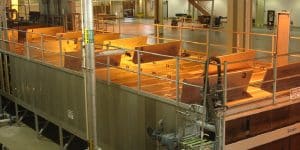Safety doors must be built to meet OSHA, MSHA, NFPA Standards, FM Global Standards, European ATEX Directives and other many other standards when needed.
Learn More About Our Safety Devices
We can help you navigate the sea of requirements that must be met to get your safety door project off the ground. While not a complete list, the following codes or individuals may contribute to your project.
- Authorities – the “AHJ” or Authority Having Jurisdiction
- National Standards
- NFPA – National Fire Protection Association
- FM – Factory Mutual Global
- Other European
- ATEX enabled
- Code Bodies
- Local
- State/Provincal
- Regional
- National such as OSHA and MSHA
- Other Interested Parties
- Safety Engineer
- Management
- Insurance carriers
They can all have specific requirements. We can help you with your approvals.
Safety Door Testing
Actual footage of a safety door test conducted in Europe had the following conclusions:
- The effectiveness of the door was initially assessed at a Pstat of 0.1 bar (i..e. an opening pressure of 40 inches of water column) and was found to be equivalent to a weak bursting (aluminium) foil, also having a Pstat of 0.1 bar.
- In subsequent tests, the lowest pressure at which the door opened with an air blast was 0.017 bar ( 6.8 inches of water column), and in the explosion tests was 0.022 bar ( 8.8 inches of water column).
This is a test of a 1 square meter PSD door relieving the explosive force from 1 kg of suspended powdered sugar.
Getting Your Project Approved
Many Groups and Departments are Involved to Reduce Explosive Conditions in Your Facilities.
The Authority Having Jurisdiction (AHJ). This is the individual or group granting occupancy for use of the protected facilities. The AHJ could be (defined by the NFPA), is:
- (F)ederal, state, local, or other regional department or individual such as a fire chief; fire marshal; chief of a fire prevention bureau, labor department, or health department; building official; electrical inspector; or others having statutory authority.
- For insurance purposes, an insurance inspection department, rating bureau, or other insurance company representative may be the authority having jurisdiction.
- In many circumstances, the property owner or his or her designated agent assumes the role of the authority having jurisdiction; at government installations, the commanding officer or departmental official may be the authority having jurisdiction.
The property owner or his or her designated agent could include:
- The Design Team
- Safety Engineering
- Process Design Engineering
- Manufacturing Engineering
NFPA Standards:
PSD Explosion Relief Doors meet the National Fire Protection Association’s NFPA 68 – Standard on Explosion Protection by Deflagration Venting.
- NFPA 68 is one of almost 300 NFPA standards that prescribe methods of Fire Protection.
- NFPA 68 calculates the minimum explosion relief door area needed to protect a structure from overpressures that would cause an explosion of that structure.
Related NFPA Standards:
- NFPA 652: Standard on the Fundamentals of Combustible Dust The overarching NFPA standard for dusts. Published in October 2015 in order to promote awareness and focus attention on critical issues facing the dust collection industry. It includes completing a Dust Hazards Analysis (DHA) – retroactively – for any facility handling a combustible dust.
- NFPA 68 is part of a series of NFPA standards preventing and protecting structures from the effects of overpressure. Other important combustible dust Codes and Standards are:
- NFPA 654 “Standard for the Prevention of Fire and Dust Explosions from the Manufacturing, Procession, and Handling of Combustible Particulate Solids” is the master document from which other Explosion avoidance standards are generated.
- NFPA 61 “Standard for the Prevention of Fires and Dust Explosions in Agricultural and Food Products Facilities”
- NFPA 69 “Standard on Explosion Prevention Systems”
- NFPA 484 “Standard for Combustible Metals, Metal Powders and Metal Dusts”
- NFPA 499 “Recommended Practice for the Classification of Combustible Dusts and of Hazardous (Classified) Locations for Electrical Installations in Chemical Process Areas”
- NFPA 664 “Standard for the Prevention of Fires and Explosions in Wood Processing and Woodworking Facilities”
- For additional information regarding the National Fire Protection Agency please visit www.nfpa.org
- These standards may have been adopted in part or in total into the building codes in your municipality.
FM Global Standards
- FM Global is a multi-faceted, multi-national insurance company specializing in loss prevention services where the risk and resulting insurance premiums are determined by engineering analysis using their Data Sheets.
- FM Data Sheets are engineering guidelines written to help reduce the chance of property losses if adopted.
- FM Global publishes about 400 Data Sheets for 17 Subject areas, of which the Series 1 – Construction and Series 7- Hazards applies to Explosion Relief in vessels. See the table below.
- The FM Approvals division of FM Global tests and approves over 30,000 in 3 main product categories.
- PSD doors fall within the Explosion venting subcategory of the Building Materials category.
- Because PSD doors are custom made to a specific size for your specific vessel, each door is not approved by FM Global.
- However, PSD will work with FM Global Engineering to meet your FM approval for your project.
- FM Engineering will calculate the minimum vent areas required based on their proprietary software. They contact you for data of your flammable materials, your vessel construction and shape, etc. and give PSD key design criteria so we can provide explosion relief doors that meet FM requirements.
Related FM Data Sheets:
- FM 7-76 Jan 2012 Prevention And Mitigation of Combustible Dust Explosion and Fire (FM 7-76 has details very similar to the NFPA 68 Standard)
- FM 7-49 Apr 2011 Emergency Venting of Vessels
- FM 7-73 Jan 2008 Dust Collectors and Collection Systems
- FM 1-44 Damage-limiting Construction
European ATEX Directives and Harmonised Standards:
- Explosive Atmosphere overpressure relief devices for European markets must meet the European ATEX directives and their related harmonised standards.
- The 27 member nations of the European Union developed an ATEX (EXplosive ATmosphere) Directive using existing European Union directives coupled with harmonised (agreed to) test Standards developed and recognized by those 27 nations.
- The two EU Directives define the various explosive atmosphere work environments and what equipment is allowed in those environments.
- The many related European Union Harmonised Standards for explosion protection describe the test methods, quality systems, and marking requirements to achieve the appropriate hazardous atmosphere certifications,.
- PSD doors are not presently tested and certified to meet the ATEX Directives for the European market. However, please contact us if you require a quote to meet ATEX certification.
OSHA Requirements
- Presently no OSHA Explosion Relief Standard.
- OSHA does also recognize dust explosions and has developed a Combustible Dust National Emphasis Program and is now developing a Dust and Gas Standard.
- Until a standard is developed, the OSHA General Duty Clause is applied to potential explosive locations.
- However, OSHA inspectors do know of the appropriate NFPA Standards, and do cite them as methods to reduce explosive situations.
- For additional information regarding the United States Occupational Safety & Health Administration visit www.osha.gov
OSHA and Grain Elevators
- OSHA has developed Standard Number:1910.272 for Special Industries, specifically for Grain Handling facilities.
MSHA Requirements
- We can build safety doors to meet all required mining occupational/employee protection standards (MSHA) when needed.
Get a Quote
Contact us to get started with a quote for a safety door.






 Contract
Contract Food & Bev
Food & Bev